By Tathya Macwan*
A few days ago, I decided to visit the famous Gir forest, which is known as the only habitat of the Asiatic lion. Instead of adopting the usual “official” route to spot the big cat through a sponsored tourist operator, which is what most people do, I decided – along with a friend and a relative – to move into the forest on our own. We hired a bike at a town called Jetpur, where I got down early in the morning following a long and tedious night-long journey in a state transport bus. We began our 71-km-long trip on the bike at around 9.30 am to reach Satadhar, a village bordering the Gir forest, where we were to spend our night at a farmhouse belonging to the relative of my friend, who had accompanied me from all the way from Anand. Here, we could easily see the thick forest, just next to the farmhouse. I went around a little, reached a small dam in the neighbourhood, photographed a crocodile, which emerged from the water body, and returned.
We were asked to sleep on the terrace. At night, we were excited to hear the roar of the lion. We were told later that two lionesses passed near the farmhouse at 5 am while we were fast asleep. The family members living on the farmhouse work often at night, as irrigation water is available only when at midnight. What shocked me was, one of the elderly persons in the family, Fulabhai Raiyani, 70, slept on the open, on the farm land. I asked him, whether he wasn’t afraid. Chewing pan masala, Raiyani was forthright: “What these creatures have got to do with me? They will never harm me.” He told me, they were used to hearing lions’ roars and grunts every night, but they never bothered. “We always sleep peacefully like this”. We could see: There was hardly any boundary surrounding the farmhouse that could keep the beast away.
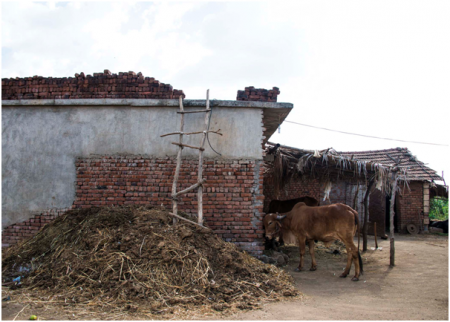
Terrace on top of the barnyard, where we stayed at night. The cattle are usually locked inside to protect them from the big cat
Ignoring the forest officials’ instruction, I decided to stop there to take a few photographs. There was a herd of buffaloes in water, and a few shepherds sat on the bank of the river. One of them quietly approached me. He asked me point blank: “Interested in seeing lions face to face?” I smiled: “That is why I have travelled for 400 km”. He said he would charge Rs 1,000. I readily agreed, but said I would pay only after I saw a lion. He agreed. One of three of the maldharis, who were to accompany us, told us how on the previous day four lions were spotted nearby, feeding on a cow which they had predated. I was thrilled. I had just begun the journey to spot a lion. But to my misfortune, I found the bike’s rear tyre had punctured. We decided to leave it there, and rode on the maldharis’ bikes.
We were a group of six, wandering deep into forest. We spotted the carcass of the cow. The area was extremely smelly, as the carcass still lying there for several hours. However, we couldn’t see any lion. The maldharis decided to leave their bikes at one spot, and we began walking, which we presumed was illegal; perhaps we could even be fined. But maldharis reassured us: We were accompanying them. There was nothing to fear. They would always walk through the forests, and the lion never harmed them. They had spotted the lions’ footprints, and were sure that the big cat was nearby. We began tracking the footprints, taking us even deeper. My heart was pumping fast, the adrenaline rush was unending. The path on which we were walking was narrow. Maldharis, lions and other animals would easily pass through here, but it was difficult for amateurs like us. We had to move on through thorny bushes, crossing fallen trees.
We spotted chinkaras and nilgais. Staying in a group is always good when entering such regions, I thought. We walked for three long hours but couldn’t find any lion. But the maldharis were confident. So we moved on. Finally, they were successful in spotting a lion. One of the maldharis asked us to look into a bush nearby. We gazed in, and after a while saw the lion sitting just about 10 feet away! We couldn’t believe that the lion could be so big and so close. After I took a few photographs, I found the lion’s mood was changing. It started waving its tail and opened the mouth; perhaps it was showing me his deadly canines. I thought it was best to leave the spot. Satisfied, we were taken by maldharis to their helmet situated nearby. One of them told me, he had named a pack of five lions that would regularly visit them — Rajyo, Shekara, Maulana, Ram and Shyam. Ram and Shyam were big ones, and also ferocious. One could spot them there during evening hours, all together, almost every third day. They would be there in search of a prey.
What particularly struck me was, none of the maldharis approved the view that the beast would ever attack humans. They told us the beast would retaliate only if humans disturb them. Otherwise, it was quite friendly. If you walk quietly, it would pass by without harming you. “Only jaguars are known to attack humans, not lions”, one of them said. My visit to the forest made me realize that there must be a symbiotic relationship between the maldharis and the big cat. Otherwise, why should they live amidst lions, in the jungle, without fear, for generations? Lions haven’t ever harmed them. Foraging their cattle through the jungle and living in open mud houses, they have set an ideal example of human-animal coexistence.
We ended our sojourn into the Gir after spotting a bike mechanic outside the sanctuary area, where we were left. The mechanic accompanied me into the forest, repaired the puncture, and we were back on our bike. The lesson I learnt was loud of clear, indeed similar to what many conservationists have long said – that the maldharis survive on milk and other products obtained from their cattle, and lions in turn depend on their cattle. Though cattle are not the only source of lions’ food, it is perhaps the most important one. While interacting with locals during our trip to the Gir, we were told that lions cross the boundary of the forest and visit villages only in search of cattle. In fact, were told many anecdotes on how lions would prey on the cattle in villages surrounding the Gir. We rode on the bike to Piyava, a village 22 km away from the Gir, where we were to spend the night.
Those who owned the farmhouse at Piyava told us that it had become quite common for lions to reach their house and take away their cattle. One of them, Jayesh, a young maldhari boy, told us how he himself chased away a lion while he took cattle for grazing in the forest! “If it is attacking our cattle, it must be really very hungry. The lion strays out of the jungle because there aren’t enough cattle left inside the forest”, we were told. Indeed, for quite some time, forest officials have been persuading the maldharis to move out of the forest, cleanse it of human interference. They do not seem to take into account the close relationship between maldharis and lions, continuing for ages. Maldharis respect the creature and the ecosystem as none else. I had reason to wonder: If all the maldharis are forced to move out of the forest, there wouldn’t be any lion left in the forest – the big cat would stray to places maldharis go with their cattle.
I was reminded of a play, titled “Akoopar”, directed by Aditi Desai, staged in several towns, cities and villages of India. It is based on a novel by Dhruv Bhatt, who himself resided in a village near the Gir for many years. The play beautifully establishes the close relation between the maldharis and the lions. At the end of the extremely adventurous trip, there are a few questions which remain unanswered. Why is the creature so used to the maldharis? Would it behave in the same manner with other humans, too? And, will we ever change our views on the creature and think how to protect it?
—
*Professional photographer and activist
http://counterview.org/2014/05/29/a-lesson-into-why-maldharis-in-the-gir-forest-know-lions-so-well-as-to-name-them-as-rajyo-shekara-maulana-ram-and-shyam/
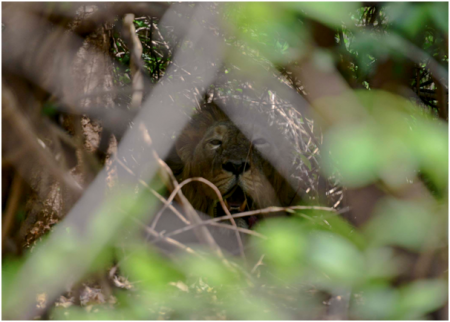
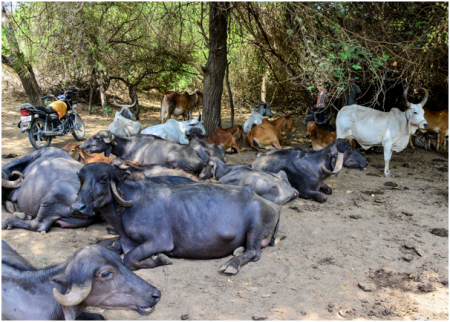
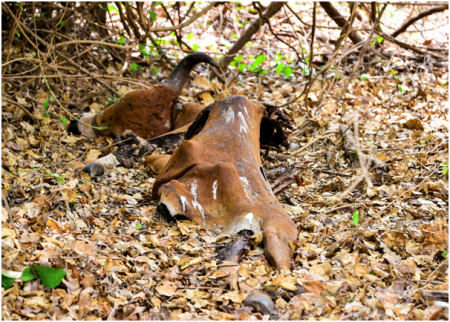
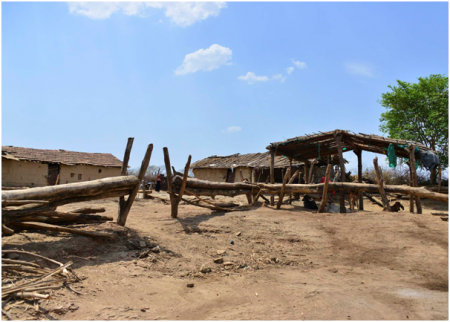
1 comment:
I visited last year with my family and have some unforgettable memories of Gir National Park.
Post a Comment